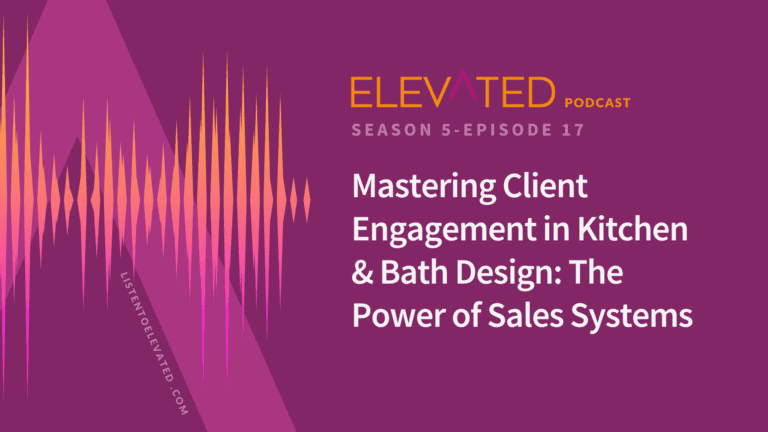Mastering Client Engagement in Kitchen & Bath Design: The Power of Sales Systems

We’re continuing to talk about specific sales system functionality and in this episode, we’re talking about email integration. If you remember, in our last episode, we discussed the magic of scheduling links. Today, we’re focusing on a key component of modern sales systems: ‘Email Integration in Sales Systems’. This feature streamlines your sales process by centralizing all communications within your system.
So, what exactly is email integration, and why do you care? Email integration is how you bring all your communications with prospects, leads, and clients into one centralized hub within your sales system. This approach, known as ‘Email Integration in Sales Systems’, represents the evolution of client communication in a digital world. It’s like having a command center for all your client interactions.
The beauty of CRM and sales systems is that they make this process seamless, gathering not just emails but also various other communication channels. Whether you’re texting, sliding into DMs on Instagram, or sending good old-fashioned emails, this feature has you covered. No more jumping between different apps or platforms to figure out where the conversation ended up.
Now, here’s why email integration is a game-changer. Picture this: you’re in the midst of a sales process, managing multiple conversations. You’re sending emails, having chats, perhaps even texting. Without email integration, it’s easy to lose track. You start asking yourself, “When was the last time I spoke with this person? Did they read the proposal? Is it time for a follow-up?”
Email integration solves all these headaches. It compiles all your interactions into one place. You can see the complete history of every conversation. And it’s not just for you; your entire team can access it. So whether you’re on vacation or just simply need someone else to jump in, they’ll have all the context they need. No more frantic messages like “What’s happening with this account?”
But the real magic happens when you understand that email integration isn’t just about convenience; it’s about turbocharging your efficiency. It serves as your one-stop-shop for all client and prospect information. That means no more scrambling to find answers, wasting time piecing together information, or getting lost in email threads.
Let’s say a prospect reaches out and expresses interest in your kitchen and bath design services. You exchange several emails, provide project details, and even discuss budget expectations. This information can end up scattered across your team’s inboxes. The designer, project manager, and sales rep may each have partial information.
Now, imagine you are using a CRM and have email integration in place. The prospect’s communication is automatically captured and organized within the sales system. The entire team can access this central hub and immediately see the full history. They know about the initial inquiry, the project details, and the budget discussions. Everyone’s on the same page without exchanging a single email. No more missed information, no more duplicated efforts, and bye-bye wasted time.
Your team knows exactly where to find the information they need. And here’s the best part: it elevates the client experience. When a client submits a request, the information goes into the system, accessible to everyone. It’s not locked in someone’s inbox; it’s out there, ready to be used by anyone who interacts with the client.
Now, you might be concerned about privacy and storage. You don’t want every single email in the CRM. But don’t worry; these integration systems are sophisticated. They allow you to decide. You can choose which emails make it into the system and which stay out. It’s all within your control.
So, here’s how to make it work for you:
Step 1: Establish the connection. If you’re using a CRM like HubSpot or Zoho, it will guide you through connecting your email provider like Google Workspace or Microsoft365. Other CRMs like Streak already live in your inbox and simply require deciding on who you are sharing with.
Step 2: Decide whether you want emails to automatically go into the system or if you prefer to choose per email what is captured. You can always change this setting as your role and needs evolve.
For example, you might be in a heavy sales cycle where around 80% of your work involves sales-related emails. In this case, you’d likely set the default to have all emails go into the system. However, as your role evolves, you might find yourself in a more CEO-focused position where sales-related emails account for less than 50% of your work. That’s when you’d change the setting to require manual selection of which emails go into the system.
In other words, it’s about adapting to your needs. You’re not locked into a single setting and you can also set additional logic. For example, if you’re dealing with a client you can set emails to and from that email address to automatically always go in the system. Conversely, if there’s an email address you never want in the system, you can exclude it.
Step 3: Use the power of your consolidated data. You can change statuses, set reminders, and track email opens and responses. It’s like having X-ray vision into your lead and client interactions.
In summary, email integration saves you time, clears communication clutter, and empowers you to provide top-notch client experiences. It’s like having a super-efficient virtual assistant who never takes a day off.
In the end, it’s not just about convenience; it’s about supercharging your sales process. Your kitchen and bath design business will run smoother than ever, and your clients will love working with you. So, go ahead, dive into email integration—it’s a game-changer you won’t want to miss out on.
Next up we’re talking about how to use your sales system to get the right information in front of prospects at the right time by looking at their interactions.
Ultimately, ‘Email Integration in Sales Systems’ isn’t just a technological advancement; it’s a strategic tool that revolutionizes how kitchen and bath design businesses manage client relationships.
Like what you heard? Never miss an episode by subscribing – you’ll find this podcast on Apple, Spotify, Amazon, I Heart Radio and everywhere else you get your podcasts.

